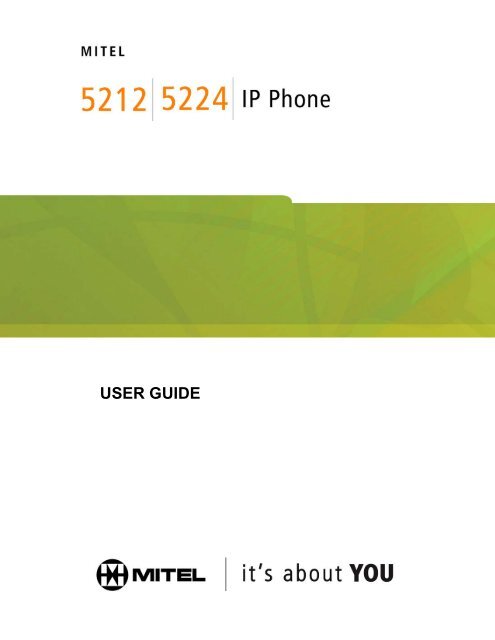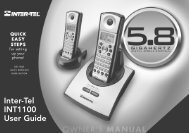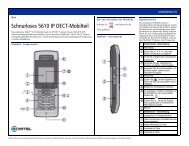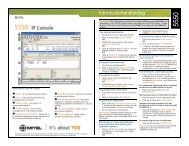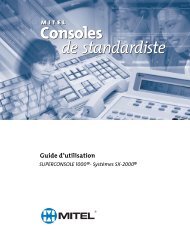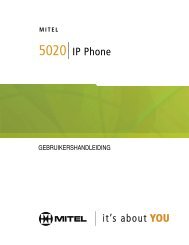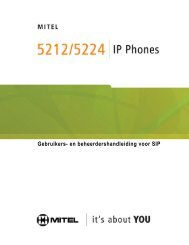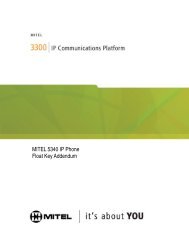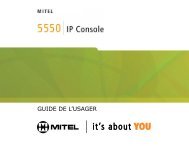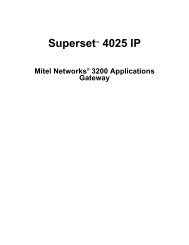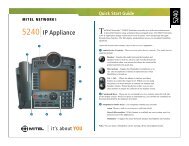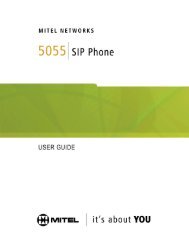User Guide for the Mitel 5212/5224 IP Phones
User Guide for the Mitel 5212/5224 IP Phones
User Guide for the Mitel 5212/5224 IP Phones
Create successful ePaper yourself
Turn your PDF publications into a flip-book with our unique Google optimized e-Paper software.
USER GUIDE
3300 ICP 7.0
Contents<br />
ABOUT YOUR PHONE 1<br />
Elements of Your Phone 4<br />
Selecting Menu Options 7<br />
Using Your <strong>IP</strong> Phone in Remote Mode 7<br />
About Feature Access Codes 7<br />
For <strong>User</strong>s on Resilient 3300 ICP Systems 8<br />
<strong>5224</strong> <strong>IP</strong> Phone Line Interface Module 8<br />
T<strong>IP</strong>S FOR YOUR COMFORT AND SAFETY 8<br />
Don't cradle <strong>the</strong> handset! 8<br />
Protect your hearing 9<br />
Adjust <strong>the</strong> viewing angle 9<br />
CUSTOMIZING YOUR <strong>5212</strong>/<strong>5224</strong> <strong>IP</strong> PHONE 10<br />
Ringer Control 10<br />
Handset Receiver Volume Control 10<br />
Speaker Volume Control 11<br />
Display Contrast Control 11<br />
Feature Keys 12<br />
Language Change 13<br />
-i-
MAKING AND ANSWERING CALLS 13<br />
Make a call 13<br />
Answer a call 13<br />
Emergency Calls 14<br />
Phonebook (<strong>5224</strong> <strong>IP</strong> Phone only) 16<br />
Redial 16<br />
Redial 16<br />
Speed Call Keys 17<br />
Speed Call 18<br />
Handsfree Operation 19<br />
Auto 20<br />
Group Listen 20<br />
CALL HANDLING 21<br />
Hold 21<br />
Mute 21<br />
Transfer 22<br />
Conference 22<br />
Conference Split 22<br />
Add Held (<strong>5224</strong> <strong>IP</strong> Phone only) 23<br />
Swap 23<br />
Call Forward 24<br />
Call Forward - Remote (I'm Here) 26<br />
Call Forward - End Chaining 27<br />
Call Forward - Forced (<strong>5224</strong> <strong>IP</strong> Phone only) 27<br />
Call Forward - Override 27<br />
Messaging - Advisory 28<br />
Messaging - Callback 29<br />
Messaging - Cancel Callback 30<br />
Messaging - Cancel All Callbacks 30<br />
-ii-
USING ADVANCED FEATURES 31<br />
Account Codes 31<br />
Attendant Call Hold - Remote Retrieve 31<br />
Call Park 32<br />
Call Pickup 33<br />
Campon 33<br />
Do Not Disturb 33<br />
Override 34<br />
Paging 34<br />
Direct Paging 34<br />
Direct Paging - Handsfree Answerback Enabled 35<br />
Direct Paging - Handsfree Answerback Disabled 37<br />
Reminder (<strong>5224</strong> <strong>IP</strong> Phone only) 38<br />
Headset Operation 39<br />
Headset Operation (with Feature Control Switch) 40<br />
Music 41<br />
Group Paging / Meet Me Answer 42<br />
Trunk Flash 42<br />
Record a Call 43<br />
Hot Desking 44<br />
Tag Call 46<br />
Call History 47<br />
Night Answer 49<br />
Release 50<br />
Mobile Extension 50<br />
USING THE LINE INTERFACE MODULE (<strong>5224</strong> <strong>IP</strong> PHONE ONLY) 50<br />
LINE INTERFACE MODULE MODE 51<br />
FAILOVER MODE 53<br />
EMERGENCY CALLS 53<br />
-iii-
ABOUT YOUR PHONE<br />
The <strong>Mitel</strong> <strong>5212</strong> and <strong>5224</strong> <strong>IP</strong> <strong>Phones</strong> are full-feature, dual port, dual mode<br />
telephones that provide voice communication over an <strong>IP</strong> network. Each<br />
features a back-lit liquid crystal display (LCD) screen, display-assisted<br />
access to features, on-hook dialing and off-hook voice announce with<br />
handsfree answerback, and a large ring/message indicator. The <strong>5212</strong> <strong>IP</strong><br />
Phone offers 12 programmable keys, and <strong>the</strong> <strong>5224</strong> <strong>IP</strong> Phone offers 24<br />
programmable keys <strong>for</strong> one-touch feature access. Both phones provide ten<br />
fixed feature keys <strong>for</strong> convenient access to features such as Conferencing,<br />
Redial, and many customizable user settings. The <strong>5212</strong> and <strong>5224</strong> <strong>IP</strong> <strong>Phones</strong><br />
support <strong>Mitel</strong> Call Control (MiNet) protocols and session initiated protocols<br />
(S<strong>IP</strong>). The <strong>5224</strong> <strong>IP</strong> Phone also supports modules such as <strong>the</strong> Line Interface<br />
Module, 5310 <strong>IP</strong> Conference Unit, and <strong>the</strong> 12 and 48 Buttom Programmable<br />
Key Modules. The <strong>5224</strong> <strong>IP</strong> Phone can be used as an ACD Agent Phone or a<br />
Teleworker phone.<br />
The personal key on <strong>the</strong> bottom left is always your Prime Line; <strong>the</strong><br />
remaining personal keys can be programmed as:<br />
Feature keys (<strong>for</strong> example, Swap). You can program feature keys from<br />
your phone, or using <strong>the</strong> Desktop Tool. Your administrator can also<br />
program feature keys.<br />
Speed Call keys. You can program speed call keys from your phone, or<br />
using <strong>the</strong> Desktop Tool.<br />
Line Appearances. Only <strong>the</strong> administrator can program line appearances.<br />
Note: For more in<strong>for</strong>mation on <strong>the</strong> Desktop Tool, talk to your system<br />
administrator.<br />
-1-
The <strong>5212</strong> <strong>IP</strong> Phone<br />
-2-
The <strong>5224</strong> <strong>IP</strong> Phone<br />
-3-
Elements of Your Phone<br />
Feature Function<br />
1 Display Provides a two–line, 20–character liquid crystal<br />
display (LCD) viewing area that assists you in<br />
selecting and using phone features, accessing your<br />
voice mail, and identifying callers. When you are<br />
using <strong>the</strong> Superkey menu interface, prompts and<br />
feature in<strong>for</strong>mation appear on <strong>the</strong> display screen. For<br />
in<strong>for</strong>mation on selecting menu options with or<br />
without softkeys, see "Selecting Menu Options"<br />
elsewhere in this guide.<br />
2 Softkeys (<strong>5224</strong> <strong>IP</strong><br />
Phone only)<br />
3 Ring/Message<br />
Indicator<br />
4 Volume, Speaker<br />
and Mute Controls<br />
Context-sensitive keys change depending on <strong>the</strong><br />
modes of <strong>the</strong> operation and <strong>the</strong> menu currently<br />
displayed. Softkeys enable you to easily view and<br />
select a variety of features.<br />
Flashes to signal an incoming call and to indicate a<br />
message waiting in your voice mailbox.<br />
Provide <strong>the</strong> following audio control capability:<br />
(UP) and (DOWN) provide volume<br />
<br />
control <strong>for</strong> <strong>the</strong> ringer, handset, and handsfree<br />
speakers.<br />
(SPEAKER) enables and disables Handsfree<br />
mode.<br />
(MUTE) enables Mute, which allows you to<br />
temporarily turn your phone's handset, headset<br />
or handsfree microphone off during a call.<br />
-4-
Feature Function<br />
5 Fixed Function Keys Give you access to <strong>the</strong> following phone functions:<br />
(SUPERKEY) : provides access to menus <strong>for</strong><br />
your phone's additional features. Note : When<br />
navigating through Superkey menu options, press<br />
(CANCEL) or (SUPERKEY) to back up<br />
one menu level.<br />
(CANCEL) : ends a call when pressed during<br />
<strong>the</strong> call, and, when you are programming <strong>the</strong><br />
phone, eliminates any input and returns to <strong>the</strong><br />
previous menu level.<br />
(REDIAL) : calls <strong>the</strong> last number dialed.<br />
(HOLD) : places <strong>the</strong> current call on hold.<br />
(TRANS/CONF) : initiates a call transfer or<br />
establishes a three–party conference call.<br />
(MESSAGE) : provides access to your voice<br />
mailbox and flashes to notify you of messages<br />
waiting in your voice mailbox. Note : The<br />
Ring/Message indicator also flashes when<br />
messages are waiting.<br />
6 Keypad Use to dial.<br />
7 Programmable Provides 12 keys that can be programmed as speed<br />
Personal Keys and call keys, feature keys, or line appearance keys,<br />
Designation Card according to your communication needs. Personal<br />
keys have status indicators. On a <strong>5224</strong> <strong>IP</strong> Phone, <strong>the</strong><br />
bottom right personal key is always your Prime Line<br />
key. On <strong>the</strong> <strong>5212</strong> <strong>IP</strong> Phone, <strong>the</strong> bottom left personal<br />
keys is always your Prime Line key. The bottom left<br />
personal key is always your Prime Line key. Write<br />
<strong>the</strong> name (speed call, feature or line appearance) of<br />
<strong>the</strong> Personal keys that you program on <strong>the</strong><br />
designation card (use <strong>the</strong> side of <strong>the</strong> card with <strong>the</strong><br />
textboxes provided). Use <strong>the</strong> slot behind <strong>the</strong> plastic<br />
cover at <strong>the</strong> bottom of <strong>the</strong> phone to remove/insert<br />
<strong>the</strong> designation card.<br />
-5-
Feature Function<br />
8 Handsfree Speaker Provides sound <strong>for</strong> Handsfree calls and background<br />
music.<br />
9 Handset Use <strong>for</strong> handset calls. If you are in headset or<br />
handsfree mode, you do not need to use <strong>the</strong><br />
handset.<br />
IMPORTANT NOTE FOR HEADSET USERS:<br />
<strong>Mitel</strong> Networks Headsets with Feature Control Switch must be installed in <strong>the</strong><br />
dedicated headset jack on <strong>the</strong> back of <strong>the</strong> phone. Installation will disable<br />
your handset microphone. Disconnecting <strong>the</strong> headset at <strong>the</strong> jack or at <strong>the</strong><br />
quick–disconnect plug restores handset operation.<br />
Ring/Message indicators<br />
When indicator is it means that<br />
Flashing rapidly Your phone is ringing<br />
Flashing slowly A message or callback message is<br />
waiting at your phone<br />
On Your phone is ringing ano<strong>the</strong>r phone<br />
Off Your phone is idle, or you are on a<br />
call<br />
-6-
Selecting Menu Options<br />
Because <strong>the</strong> <strong>5224</strong> <strong>IP</strong> Phone offers softkeys, feature availability and menu<br />
options <strong>for</strong> <strong>the</strong> <strong>5212</strong> and <strong>5224</strong> <strong>IP</strong> <strong>Phones</strong> may differ.<br />
To select menu items on <strong>the</strong> display:<br />
1. On a <strong>5224</strong> <strong>IP</strong> Phone, press <strong>the</strong> softkeys.<br />
2. On a <strong>5212</strong> <strong>IP</strong> Phone, press *, 0 and # on <strong>the</strong> keypad. For example, if<br />
options *=YES 0=DEFAULT #=NO appear and you want to select YES,<br />
press *.<br />
Procedures in this guide show all menu selection options, where applicable—<br />
<strong>for</strong> example, "Press <strong>the</strong> * or Yes softkey". Procedures in this guide also<br />
specify when a menu option is available on only one of <strong>the</strong> phones—<strong>for</strong><br />
example, "On a <strong>5224</strong> <strong>IP</strong> Phone only, press <strong>the</strong> Save softkey".<br />
Using Your <strong>IP</strong> Phone in Remote Mode<br />
Remote Mode allows <strong>the</strong> <strong>5212</strong> and <strong>5224</strong> <strong>IP</strong> Phone to be used in <strong>the</strong> home or<br />
in o<strong>the</strong>r locations away from <strong>the</strong> office. For in<strong>for</strong>mation on how to program<br />
your <strong>IP</strong> Phone <strong>for</strong> remote operation, refer to <strong>the</strong> Remote <strong>IP</strong> <strong>Phones</strong> <strong>Guide</strong><br />
available at www.mitel.com<br />
About Feature Access Codes<br />
Use of some features requires dialing access codes. The codes are flexible<br />
and may be different than those in this guide. Ask your Administrator <strong>for</strong> a<br />
list of codes you should use.<br />
-7-
For <strong>User</strong>s on Resilient 3300 ICP Systems<br />
If during a call, you hear two beeps repeated every 20 seconds it means that<br />
your phone is switching to a secondary 3300 ICP system. The call continues<br />
but some of <strong>the</strong> keys and features on your phone function differently. The<br />
keys and most features begin working normally again after you hang up. If<br />
your phone switches to <strong>the</strong> secondary system while your speaker or handset<br />
is muted (that is, while <strong>the</strong> MUTE light is on), <strong>the</strong> call remains muted until<br />
you hang up. Normal operation resumes when your phone switches back to<br />
<strong>the</strong> primary system. If your phone is idle and switched to <strong>the</strong> secondary<br />
system, you'll see a flashing rectangle on <strong>the</strong> display. The rectangle remains<br />
until <strong>the</strong> switch to <strong>the</strong> primary system is complete.<br />
<strong>5224</strong> <strong>IP</strong> Phone Line Interface Module<br />
The Line Interface Module is an optional device that adds an analog phone<br />
line (POTS) capability to your <strong>5224</strong> <strong>IP</strong> phone only. If Emergency Call Routing<br />
is not programmed on your 3300 ICP, you must use <strong>the</strong> Line Interface<br />
Module to dial emergency calls. For more in<strong>for</strong>mation on emergency number<br />
dialing, refer to Emergency Calls. If you have a Line Interface Module<br />
connected to your <strong>5224</strong> <strong>IP</strong> Phone, all programming of <strong>the</strong> Line Interface<br />
Module, except <strong>the</strong> Analog Key, is done by <strong>the</strong> Installer when your phone is<br />
installed. For more in<strong>for</strong>mation, refer to "Using <strong>the</strong> Line Interface Module"<br />
elsewhere in this guide.<br />
Note: The <strong>5212</strong> <strong>IP</strong> Phone does not support <strong>the</strong> Line Interface Module.<br />
T<strong>IP</strong>S FOR YOUR COMFORT AND SAFETY<br />
Don't cradle <strong>the</strong> handset!<br />
Prolonged use of <strong>the</strong> handset can lead to neck, shoulder, or back discom<strong>for</strong>t,<br />
especially if you cradle <strong>the</strong> handset between your ear and shoulder. If you<br />
use your phone a lot, you may find it more com<strong>for</strong>table to use a headset.<br />
See <strong>the</strong> section on headset usage elsewhere in this guide <strong>for</strong> more<br />
in<strong>for</strong>mation.<br />
-8-
Protect your hearing<br />
Your phone has a control <strong>for</strong> adjusting <strong>the</strong> volume of <strong>the</strong> handset receiver or<br />
headset. Because continuous exposure to loud sounds can contribute to<br />
hearing loss, keep <strong>the</strong> volume at a moderate level.<br />
IMPORTANT NOTE FOR HEADSET USERS: <strong>Mitel</strong> Headsets with Feature<br />
Control Switch must be installed in <strong>the</strong> dedicated headset jack (<strong>the</strong> jack on<br />
<strong>the</strong> back of <strong>the</strong> phone). Installation will disable your handset microphone.<br />
Disconnecting <strong>the</strong> headset at <strong>the</strong> jack or at <strong>the</strong> quick-disconnect plug<br />
restores handset operation.<br />
Adjust <strong>the</strong> viewing angle<br />
The stand built into your phone tilts to give you a better view of <strong>the</strong> keys.<br />
To tilt your telephone <strong>for</strong> better viewing:<br />
1. Turn <strong>the</strong> phone so that <strong>the</strong> front faces away from you.<br />
2. Hold <strong>the</strong> base unit firmly and press <strong>the</strong> release tabs on <strong>the</strong> sides of <strong>the</strong><br />
stand to detach <strong>the</strong> base unit.<br />
3. Hinge <strong>the</strong> hooks of <strong>the</strong> base unit into <strong>the</strong> notches on <strong>the</strong> back of <strong>the</strong><br />
phone and snap into place as follows:<br />
a. For a high–angle mount, hinge <strong>the</strong> two lower hooks into <strong>the</strong> bottom<br />
set of notches and snap <strong>the</strong> two upper hooks into <strong>the</strong> middle set of<br />
notches.<br />
b. For a low–angle mount, hinge <strong>the</strong> two lower hooks into <strong>the</strong> middle set<br />
of notches and snap <strong>the</strong> two upper hooks into <strong>the</strong> top set of notches.<br />
-9-
CUSTOMIZING YOUR <strong>5212</strong>/<strong>5224</strong> <strong>IP</strong> PHONE<br />
Ringer Control<br />
To adjust <strong>the</strong> Ringer Volume while <strong>the</strong> set is ringing:<br />
Press ( UP ) or ( DOWN ).<br />
To adjust <strong>the</strong> Ringer Pitch while <strong>the</strong> set is idle:<br />
1. Press ( SUPERKEY ). .<br />
2. Press # or <strong>the</strong> No softkey until "Ringer Adjust?" appears.<br />
3. Press * or <strong>the</strong> Yes softkey twice.<br />
4. Press ( UP ) or ( DOWN ).<br />
5. Press ( SUPERKEY ).<br />
Handset Receiver Volume Control<br />
To adjust <strong>the</strong> Handset Receiver Volume when you are using <strong>the</strong><br />
handset:<br />
Press ( UP ) or ( DOWN ).<br />
-10-
Speaker Volume Control<br />
To adjust <strong>the</strong> Speaker Volume when making an on–hook call or when<br />
listening to background music:<br />
Press ( UP ) or ( DOWN ).<br />
Display Contrast Control<br />
To adjust <strong>the</strong> Display Contrast while your set is idle:<br />
Press ( UP ) or ( DOWN ).<br />
-11-
Feature Keys<br />
You can use ( SUPERKEY ) on your phone or <strong>the</strong> Desktop Tool to<br />
program <strong>the</strong> personal keys as feature keys. The Desktop Tool is a browser–<br />
based interface that makes programming quick and easy. For more<br />
in<strong>for</strong>mation on using <strong>the</strong> Desktop Tool, please contact your System<br />
Administrator.<br />
NOTE: You can only use <strong>the</strong> key on <strong>the</strong> <strong>5212</strong> <strong>IP</strong> Phone to program<br />
Speed Call keys. See "Speed Call Keys" elsewhere <strong>for</strong> more in<strong>for</strong>mation.<br />
To program some features to a personal key, you must dial a feature access<br />
code. A list of access codes is provided elsewhere in this guide; however, <strong>the</strong><br />
codes are flexible and may be different than those in this guide. Ask your<br />
Administrator <strong>for</strong> a list of codes you can use.<br />
To display in<strong>for</strong>mation about a key:<br />
1. Press ( SUPERKEY ).<br />
2. Press a personal key that isn't a line key.<br />
3. Press ( SUPERKEY ).<br />
To program a personal key (<strong>5224</strong> <strong>IP</strong> Phone Only):<br />
1. Press ( SUPERKEY ).<br />
2. Press # or <strong>the</strong> No softkey until "Personal Keys?" appears.<br />
3. Press * or <strong>the</strong> Yes softkey.<br />
4. Press a personal key that isn't a line key.<br />
5. Press * or <strong>the</strong> Change softkey.<br />
6. Press # or <strong>the</strong> No softkey until <strong>the</strong> desired feature appears.<br />
7. Press * or <strong>the</strong> Yes softkey.<br />
8. Press ( SUPERKEY ), or press ano<strong>the</strong>r personal key and proceed to<br />
program ano<strong>the</strong>r feature.<br />
9. Write <strong>the</strong> feature name on <strong>the</strong> key label.<br />
-12-
Language Change<br />
To change <strong>the</strong> display language:<br />
1. Press ( SUPERKEY ).<br />
2. Press # or <strong>the</strong> No softkey until "Language?" appears.<br />
3. Press * or <strong>the</strong> Yes softkey.<br />
4. Press * or <strong>the</strong> Change softkey.<br />
5. Press # or <strong>the</strong> No softkey until <strong>the</strong> desired language appears.<br />
6. Press * or <strong>the</strong> Yes softkey.<br />
MAKING AND ANSWERING CALLS<br />
Make a call<br />
1. Lift <strong>the</strong> handset (optional).<br />
2. If you want to use a Non–Prime Line, press a Line Appearance key.<br />
3. Do one of <strong>the</strong> following:<br />
Dial <strong>the</strong> number<br />
Press a Speed Call key<br />
Press ( REDIAL ).<br />
Answer a call<br />
Do one of <strong>the</strong> following:<br />
Lift <strong>the</strong> handset.<br />
Press ( SPEAKER ).<br />
Press <strong>the</strong> flashing Line appearance key and lift <strong>the</strong> handset.<br />
Press <strong>the</strong> flashing Line appearance key and press ( SPEAKER ).<br />
-13-
Emergency Calls<br />
Warning <strong>for</strong> emergency number dialing: Consult your local authorities<br />
<strong>for</strong> Emergency Numbers and 911 or equivalent service availability in your<br />
area.<br />
There are two methods of dialing emergency numbers, based on <strong>the</strong><br />
programming of your 3300 ICP:<br />
Emergency Call Routing NOT programmed<br />
Emergency Call Routing programmed<br />
Caution: Verify with your System Administrator which type of emergency<br />
number dialing you can use.<br />
EMERGENCY CALLS WHEN EMERGENCY CALL ROUTING NOT<br />
PROGRAMMED<br />
If Emergency Call Routing is NOT programmed, Emergency Number<br />
dialing should only be per<strong>for</strong>med by picking up <strong>the</strong> handset and<br />
selecting <strong>the</strong> Line Interface Module key you have programmed. If<br />
Privacy Mode is enabled and <strong>the</strong> Line Interface Module key local line<br />
is busy, dialing will not occur on <strong>the</strong> Line Interface Module line.<br />
Emergency dialing using an <strong>IP</strong> connection may not be supported due to ICP<br />
system configuration and country location. For more in<strong>for</strong>mation, contact<br />
your System Administrator.<br />
To make an Emergency Call using <strong>the</strong> Line Interface Module line:<br />
1. Lift <strong>the</strong> handset.<br />
2. Press <strong>the</strong> Line Interface Module key that you have programmed.<br />
The set indicates <strong>IP</strong> FAIL: ANALOG CALL<br />
3. Dial your Local Emergency Number.<br />
-14-
To make an Emergency Call using <strong>the</strong> Line Interface Module line, when<br />
<strong>the</strong> <strong>IP</strong> connection has failed:<br />
1. Lift <strong>the</strong> handset.<br />
2. Press <strong>the</strong> Line Interface Module key that you have programmed.<br />
The set indicates <strong>IP</strong> FAIL: ANALOG CALL.<br />
3. Dial your Local Emergency Number.<br />
EMERGENCY CALLS WHEN EMERGENCY CALL ROUTING<br />
PROGRAMMED<br />
Note: This procedure is in addition to <strong>the</strong> methods described above.<br />
To make an Emergency Call if Emergency Call Routing is programmed:<br />
1. Lift <strong>the</strong> handset.<br />
2. Dial your Local Emergency Number (911 or equivalent).<br />
For more in<strong>for</strong>mation on using <strong>the</strong> Line Interface Module line, refer to Using<br />
<strong>the</strong> Line Interface Module.<br />
-15-
Phonebook (<strong>5224</strong> <strong>IP</strong> Phone only)<br />
To use Phonebook: :<br />
Press (SUPERKEY).<br />
Press <strong>the</strong> Yes softkey when "Phonebook?" appears.<br />
Enter <strong>the</strong> last name of <strong>the</strong> desired party, as follows:<br />
For each letter in <strong>the</strong> name, press <strong>the</strong> appropriate key on <strong>the</strong> keypad<br />
until <strong>the</strong> letter is shown in <strong>the</strong> display. For example, if <strong>the</strong> letter C is<br />
required, press <strong>the</strong> digit 2 three times.<br />
Use <strong>the</strong> softkey be<strong>for</strong>e proceeding.<br />
If required, press —> softkey to add a space between <strong>the</strong> first and last<br />
name.<br />
Press <strong>the</strong> Lookup softkey.<br />
If no match exists, edit <strong>the</strong> original entry.<br />
If more than one match is found, press <strong>the</strong> Next softkey.<br />
Do one of <strong>the</strong> following:<br />
To make <strong>the</strong> call, press <strong>the</strong> Call softkey.<br />
To edit <strong>the</strong> entry, press <strong>the</strong> Retry softkey.<br />
To exit, press (SUPERKEY).<br />
Redial<br />
To redial <strong>the</strong> last number that you manually dialed:<br />
1. Lift <strong>the</strong> handset (optional).<br />
2. Press ( REDIAL ).<br />
Redial – Saved Number<br />
To save <strong>the</strong> last number that you manually dialed:<br />
Lift <strong>the</strong> handset, and <strong>the</strong>n dial **79.<br />
To Redial a saved number:<br />
Lift <strong>the</strong> handset, and <strong>the</strong>n dial *6*.<br />
-16-
Speed Call Keys<br />
You may use Speed Call Keys to make a call or to send a string of digits<br />
during a call (press a Speed Call Key during a call to send a multi–digit<br />
password, <strong>for</strong> instance).<br />
To dial a stored Speed Call number:<br />
1. Lift <strong>the</strong> handset.<br />
2. Press a Speed Call key.<br />
To store a Speed Call number:<br />
1. Press ( SUPERKEY ).<br />
2. Press # or <strong>the</strong> No softkey until "Personal Keys?" appears.<br />
3. Press * or <strong>the</strong> Yes softkey.<br />
4. Press a personal key that isn't a line key.<br />
5. Press * or <strong>the</strong> Change softkey<br />
6. On a <strong>5224</strong> <strong>IP</strong> Phone only, press <strong>the</strong> Yes softkey.<br />
7. Do one of <strong>the</strong> following:<br />
To enter a new number, dial <strong>the</strong> number (press ( HOLD )<br />
between digits to create a one–second pause during dialing; press<br />
( HOLD ) more than once to leng<strong>the</strong>n <strong>the</strong> pause.)<br />
To enter a trunk flash, press ( TRANS/CONF ). (See "Trunk<br />
Flash" <strong>for</strong> more in<strong>for</strong>mation about <strong>the</strong> use of this feature.)<br />
To enter <strong>the</strong> last number dialed, press ( REDIAL ).<br />
8. On a <strong>5212</strong> <strong>IP</strong> Phone only, press <strong>the</strong> personal key again.<br />
9. Do one of <strong>the</strong> following:<br />
To make <strong>the</strong> number private, press * or <strong>the</strong> Priv softkey<br />
To keep <strong>the</strong> number visible, press # or <strong>the</strong> Save softkey.<br />
10. Press ( SUPERKEY ).<br />
-17-
Speed Call – Personal<br />
To dial a stored personal Speed Call number:<br />
1. Lift <strong>the</strong> handset.<br />
2. Dial *58.<br />
3. Enter an index number between 00 and 09.<br />
To store a personal Speed Call number:<br />
1. Lift <strong>the</strong> handset.<br />
2. Dial *67.<br />
3. Enter an index number between 00 and 09.<br />
4. Dial <strong>the</strong> number to be stored (press ( HOLD ) between digits to<br />
create a one–second pause during dialing; press ( HOLD ) more<br />
than once to leng<strong>the</strong>n <strong>the</strong> pause.)<br />
5. Hang up.<br />
-18-
Handsfree Operation<br />
To use Handsfree to make a call:<br />
1. If you want to use a Non–Prime Line, press a Line Appearance key.<br />
Note: Your administrator must program Line Appearances to your phone.<br />
2. Dial <strong>the</strong> number.<br />
3. Begin speaking when <strong>the</strong> called party answers. Your phone's Handsfree<br />
microphone and Handsfree speaker transmit and receive audio.<br />
To use Handsfree operation to answer calls:<br />
1. Press <strong>the</strong> flashing line key.<br />
2. Begin speaking. Your phone's Handsfree microphone and Handsfree<br />
speaker transmit and receive audio.<br />
To hang up while using Handsfree operation:<br />
Press ( SPEAKER ).<br />
To turn Mute on during Handsfree operation:<br />
Press ( MUTE ).The Mute key light turns ON.<br />
To turn Mute off and return to conversation:<br />
Press ( MUTE ).The Mute key light turns OFF.<br />
To disable Handsfree operation:<br />
Lift <strong>the</strong> handset.<br />
To return to Handsfree operation:<br />
1. Press ( SPEAKER ).<br />
2. Hang up <strong>the</strong> handset.<br />
-19-
Auto–Answer<br />
To enable or disable Auto–Answer:<br />
Press <strong>the</strong> Auto–Answer feature key.<br />
To enable or disable Auto-Answer on a <strong>5224</strong> <strong>IP</strong> Phone only:<br />
1. Press ( SUPERKEY ).<br />
2. Press <strong>the</strong> No softkey until "Auto Answer?" appears.<br />
3. Do one of <strong>the</strong> following:<br />
To enable Auto-Answer, press <strong>the</strong> TurnOn softkey.<br />
To disable Auto-Answer, press <strong>the</strong> TurnOff softkey.<br />
To answer a call when you hear ringback:<br />
Begin speaking. Your phone's Handsfree microphone and Handsfree<br />
speaker transmit and receive audio.<br />
To end a call, do one of <strong>the</strong> following:<br />
On a <strong>5224</strong> <strong>IP</strong> Phone only, press <strong>the</strong> Hang up softkey.<br />
Press ( CANCEL ).<br />
Wait <strong>for</strong> <strong>the</strong> caller to hang up.<br />
Group Listen<br />
With Group Listen you can carry on a conversation using <strong>the</strong> handset or<br />
headset while allowing o<strong>the</strong>rs nearby to listen to <strong>the</strong> person at <strong>the</strong> far end<br />
over <strong>the</strong> handsfree speaker in your phone. While Group Listen is active, <strong>the</strong><br />
handsfree microphone in your phone is turned off.<br />
To allow o<strong>the</strong>rs in <strong>the</strong> room to listen to <strong>the</strong> far end of your call:<br />
Press <strong>the</strong> Group Listen feature key.<br />
To return to a private two-way call from Group Listen:<br />
Press <strong>the</strong> Group Listen feature key.<br />
To change a Group Listen call into a Handsfree call so that o<strong>the</strong>rs in<br />
<strong>the</strong> room can join <strong>the</strong> conversation:<br />
1. Press (SPEAKER).<br />
2. Hang up <strong>the</strong> handset.<br />
-20-
CALL HANDLING<br />
Hold<br />
To place a call on Hold:<br />
Press ( HOLD ).<br />
To retrieve a call from Hold:<br />
1. Lift <strong>the</strong> handset.<br />
2. Press <strong>the</strong> flashing line key.<br />
To retrieve a call from Hold at ano<strong>the</strong>r phone, do one of <strong>the</strong> following:<br />
Press <strong>the</strong> flashing line key.<br />
Dial **1 and <strong>the</strong> number of <strong>the</strong> station that placed <strong>the</strong> call on Hold.<br />
Mute<br />
Mute lets you temporarily turn your phone's handset, headset or handsfree<br />
microphone off during a call.<br />
To turn Mute on during a call:<br />
Press ( MUTE ). The ( MUTE ) light turns ON.<br />
To turn Mute off and return to <strong>the</strong> conversation:<br />
Press ( MUTE ). The ( MUTE ) light turns OFF.<br />
Note: If you are on a Handsfree MUTED call and you lift <strong>the</strong> handset, <strong>the</strong><br />
handset microphone is automatically enabled and <strong>the</strong> MUTE light turns OFF.<br />
NOTE FOR USERS ON RESILIENT 3300 ICP SYSTEMS: If your phone switches<br />
to <strong>the</strong> secondary system while your speaker or handset is muted (that is,<br />
while <strong>the</strong> Mute key is lit) <strong>the</strong> call remains muted until you hang up.<br />
-21-
Transfer<br />
To Transfer an active call:<br />
1. Press ( TRANS/CONF ).<br />
2. Dial <strong>the</strong> number of <strong>the</strong> third party.<br />
3. Do one of <strong>the</strong> following:<br />
To complete <strong>the</strong> Transfer, hang up.<br />
To announce <strong>the</strong> Transfer, wait <strong>for</strong> an answer, consult, and hang up.<br />
To cancel <strong>the</strong> Transfer, press ( CANCEL ).<br />
To transfer an active call during headset operation:<br />
1. Press ( TRANS/CONF ).<br />
2. Dial <strong>the</strong> number of <strong>the</strong> third party.<br />
3. To complete <strong>the</strong> Transfer, press <strong>the</strong> Release feature key.<br />
Conference<br />
To <strong>for</strong>m a Conference when a two–party call is already in place, or to<br />
add ano<strong>the</strong>r party to an existing Conference:<br />
1. Press ( TRANS/CONF ).<br />
2. Dial <strong>the</strong> number of <strong>the</strong> next party.<br />
3. Wait <strong>for</strong> an answer.<br />
4. Press ( TRANS/CONF ).<br />
To leave a Conference:<br />
Hang up or press ( CANCEL ).<br />
Conference Split<br />
To Split a Conference and speak privately with <strong>the</strong> original party on a<br />
<strong>5212</strong> <strong>IP</strong> Phone (only):<br />
1. Press ( TRANS/CONF ).<br />
2. Dial *41.<br />
To Split a Conference and speak privately with <strong>the</strong> original party on a<br />
<strong>5224</strong> <strong>IP</strong> Phone (only):<br />
Press <strong>the</strong> Split softkey.<br />
-22-
Add Held (<strong>5224</strong> <strong>IP</strong> Phone only)<br />
To move a call on hold to ano<strong>the</strong>r line appearance:<br />
1. Press an available line key.<br />
2. Press <strong>the</strong> AddHeld softkey.<br />
3. Press <strong>the</strong> flashing line key.<br />
To add a call on Hold to an existing conversation or conference:<br />
1. Press <strong>the</strong> AddHeld softkey.<br />
2. Press <strong>the</strong> flashing line key.<br />
Swap<br />
To call ano<strong>the</strong>r party when you are in an established two–party call:<br />
1. Press ( TRANS/CONF ).<br />
2. Dial <strong>the</strong> number.<br />
To alternate between <strong>the</strong> two parties:<br />
Press <strong>the</strong> Swap/Trade feature key or <strong>the</strong> Trade softkey.<br />
-23-
Call Forward<br />
Call Forward lets you redirect incoming calls to an alternate number.You can<br />
select one of <strong>the</strong> following <strong>for</strong>warding options:<br />
Always redirects all incoming calls regardless of <strong>the</strong> state of your<br />
telephone.<br />
B–Int redirects internal calls when your telephone is busy.<br />
B–EXt redirects external calls when your telephone is busy.<br />
NA–Int redirects internal calls after several rings if you don't answer.<br />
NA–Ext redirects external calls after several rings if you don't answer.<br />
Note: For in<strong>for</strong>mation about "I'm Here?", see Call Forward – Remote.<br />
To program Call Forward:<br />
1. Press ( SUPERKEY ).<br />
2. Press # or <strong>the</strong> No softkey until "Call Forwarding?" appears.<br />
3. Press * or <strong>the</strong> Yes softkey .<br />
4. Press # or <strong>the</strong> Next softkey until <strong>the</strong> type of Call Forward that you want<br />
to set up appears (see above).<br />
5. On a <strong>5224</strong> <strong>IP</strong> Phone only, press <strong>the</strong> Review softkey.<br />
6. If a number is already programmed, press * or <strong>the</strong> Change softkey .<br />
7. Press * or <strong>the</strong> Program softkey .<br />
8. Dial <strong>the</strong> destination number.<br />
If you make an error while dialing, press * or <strong>the</strong>
To turn Call Forward on and off (once it has been programmed):<br />
1. Press ( SUPERKEY ).<br />
2. Press # or <strong>the</strong> No softkey until "Call Forwarding?" appears.<br />
3. Press * or <strong>the</strong> Yes softkey .<br />
4. Press # or <strong>the</strong> Next softkey until <strong>the</strong> type of Call Forward appears. .<br />
5. Do one of <strong>the</strong> following:<br />
On a <strong>5212</strong> <strong>IP</strong> Phone, press * ( Change ) and <strong>the</strong>n press #<br />
( TurnOff/TurnOn )<br />
On a <strong>5224</strong> <strong>IP</strong> Phone, press <strong>the</strong> Review softkey. Press <strong>the</strong> Change<br />
softkey. To turn Call Forward on, press <strong>the</strong> TurnOn softkey, or, to<br />
turn Call Forward off, press <strong>the</strong> TurnOff softkey.<br />
-25-
Call Forward - Remote (I'm Here)<br />
To <strong>for</strong>ward calls from a remote station to your current location:<br />
1. Press ( SUPERKEY ).<br />
2. Press # or <strong>the</strong> No softkey until "Call Forwarding?" appears.<br />
3. Press * or <strong>the</strong> Yes softkey.<br />
4. Press # or <strong>the</strong> Next softkey until "I Am Here" appears.<br />
5. Press * or <strong>the</strong> Yes softkey.<br />
6. On a <strong>5212</strong> <strong>IP</strong> Phone only, if a number is already programmed, press *<br />
twice.<br />
7. Dial <strong>the</strong> extension of <strong>the</strong> remote station.<br />
If you make an error while dialing, use <strong>the</strong> # or <strong>the</strong>
Call Forward - End Chaining<br />
To ensure that calls do not get <strong>for</strong>warded again by <strong>the</strong> destination<br />
number:<br />
1. Lift <strong>the</strong> handset.<br />
2. Dial 64.<br />
3. Hang up.<br />
To again allow calls to be <strong>for</strong>warded by <strong>the</strong> destination number:<br />
1. Lift <strong>the</strong> handset.<br />
2. Dial **73.<br />
3. Hang up.<br />
Call Forward - Forced (<strong>5224</strong> <strong>IP</strong> Phone only)<br />
To <strong>for</strong>ce an incoming call to be <strong>for</strong>warded:<br />
Press <strong>the</strong> Forward softkey.<br />
Call Forward - Override<br />
To override Call Forward and ring a station:<br />
1. Lift <strong>the</strong> handset.<br />
2. Dial *1*.<br />
3. Dial <strong>the</strong> extension number.<br />
-27-
Messaging - Advisory<br />
Advisory Messaging enables you to select a notice that appears on your<br />
phone display to in<strong>for</strong>m people visiting your desk of your whereabouts.<br />
Select from a variety of advisory messages, including "On vacation", "In a<br />
meeting", or "Out to Lunch".<br />
To turn Messaging - Advisory on:<br />
1. Press ( SUPERKEY ).<br />
2. If necessary, press <strong>the</strong> # or <strong>the</strong> No softkey until "Advisory Msgs?"<br />
appears.<br />
3. Press * or <strong>the</strong> Yes softkey when "Advisory Msgs?" appears.<br />
4. Press # or <strong>the</strong> Next softkey until <strong>the</strong> desired message appears.<br />
5. Press * or <strong>the</strong> TurnOn softkey.<br />
To turn Messaging - Advisory off:<br />
1. Press ( SUPERKEY ).<br />
2. If necessary, press <strong>the</strong> # or <strong>the</strong> No softkey until "Advisory Msgs?"<br />
appears. .<br />
3. Press * or <strong>the</strong> Yes softkey when "Advisory Msgs?" appears.<br />
4. Press * or <strong>the</strong> TurnOff softkey .<br />
-28-
Messaging - Callback<br />
To leave a Callback Message when you hear busy or ringback tone:<br />
Press ( MESSAGE ) or, on a <strong>5224</strong> <strong>IP</strong> Phone only, press <strong>the</strong> Callback<br />
softkey.<br />
To respond to a message waiting condition on your <strong>5212</strong> <strong>IP</strong> Phone:<br />
1. Press ( MESSAGE ).<br />
2. If a password is required, dial your password.<br />
3. Do one or all of <strong>the</strong> following:<br />
To call <strong>the</strong> message sender, press #.<br />
To erase <strong>the</strong> message, press *.<br />
To respond to a message waiting condition on your <strong>5224</strong> <strong>IP</strong> Phone:<br />
1. Press ( MESSAGE ).<br />
2. If a password is required, dial your password (and press <strong>the</strong> Enter<br />
softkey if available).<br />
3. Press <strong>the</strong> Yes softkey, and do one or all of <strong>the</strong> following:<br />
To display <strong>the</strong> time <strong>the</strong> message was sent, press <strong>the</strong> More softkey.<br />
To display <strong>the</strong> number of <strong>the</strong> caller, press <strong>the</strong> More softkey twice.<br />
To call <strong>the</strong> message sender, press <strong>the</strong> Call softkey.<br />
To delete <strong>the</strong> message, press <strong>the</strong> Erase softkey.<br />
To view <strong>the</strong> next message, press ( MESSAGE ).<br />
On a <strong>5224</strong> <strong>IP</strong> Phone only, you can check <strong>for</strong> messages from a remote<br />
station:<br />
1. Press ( SUPERKEY ).<br />
2. Press <strong>the</strong> No softkey until "Remote Msging?" appears.<br />
3. Press <strong>the</strong> Yes softkey.<br />
4. Dial your extension number.<br />
5. Press <strong>the</strong> Enter softkey.<br />
6. If a password is required, enter your password and press <strong>the</strong> Enter<br />
softkey.<br />
7. Press <strong>the</strong> Yes softkey.<br />
-29-
On a <strong>5224</strong> <strong>IP</strong> Phone only, you can set, change, or clear a password (up<br />
to 7 digits, not including 0):<br />
1. Press ( SUPERKEY ).<br />
2. Press <strong>the</strong> No softkey until "Set Password?" appears.<br />
3. Press <strong>the</strong> Yes softkey.<br />
4. Do one of <strong>the</strong> following:<br />
To enter a new password, enter your password.<br />
To change or clear your password, enter your current password.<br />
5. Press <strong>the</strong> Enter softkey.<br />
6. changing or clearing your password, do one of <strong>the</strong> following:<br />
To change your password, enter your new password and press <strong>the</strong><br />
Enter softkey.<br />
To clear your password, enter 0.<br />
7. Enter your new password again.<br />
8. If you are setting up or changing a password, press <strong>the</strong> Enter softkey.<br />
9. Press ( SUPERKEY ).<br />
Messaging - Cancel Callback<br />
To cancel a Callback:<br />
1. Lift <strong>the</strong> handset.<br />
2. Dial *1#.<br />
3. Dial <strong>the</strong> number of <strong>the</strong> called station.<br />
4. Hang up.<br />
Messaging - Cancel All Callbacks<br />
To cancel all Callbacks:<br />
1. Lift <strong>the</strong> handset.<br />
2. Dial #1.<br />
3. Hang up.<br />
-30-
USING ADVANCED FEATURES<br />
Account Codes<br />
To use Forced Account Codes:<br />
1. Lift <strong>the</strong> handset.<br />
2. Dial <strong>the</strong> Account Code digits.<br />
3. Press #.<br />
To enter an Account Code during a call on a <strong>5212</strong> <strong>IP</strong> Phone:<br />
1. Press ( TRANS/CONF ).<br />
2. Dial **3.<br />
3. Dial <strong>the</strong> Account Code digits.<br />
4. Press #.<br />
5. Press ( CANCEL ).<br />
To enter an Account Code during a call on a <strong>5224</strong> <strong>IP</strong> Phone:<br />
1. Press ( SUPERKEY ).<br />
2. Press <strong>the</strong> Yes softkey.<br />
3. Dial <strong>the</strong> Account Code digits.<br />
4. Press <strong>the</strong> Save softkey.<br />
5. Do one of <strong>the</strong> following:<br />
For a verified account code, press <strong>the</strong> Yes softkey.<br />
For a non-verified account code, press <strong>the</strong> No softkey.<br />
Attendant Call Hold - Remote Retrieve<br />
To retrieve a call placed on Hold by <strong>the</strong> attendant:<br />
1. Lift <strong>the</strong> handset.<br />
2. Dial *23.<br />
3. Dial <strong>the</strong> digits announced by <strong>the</strong> attendant.<br />
-31-
Call Park<br />
The Call Park feature allows you to place a call in a special hold state. You,<br />
or someone else, can <strong>the</strong>n retrieve <strong>the</strong> call from any extension in <strong>the</strong><br />
system.<br />
After parking <strong>the</strong> call, <strong>the</strong> system can automatically connect you to paging<br />
equipment so that you can announce <strong>the</strong> call to <strong>the</strong> requested party.<br />
To park an active call:<br />
1. Do one of <strong>the</strong> following:<br />
Press <strong>the</strong> Call Park feature key (must be programmed)<br />
Press ( TRANS/CONF ), and <strong>the</strong>n dial *7#.<br />
The display shows PARKED@, followed by <strong>the</strong> park destination and<br />
parking spot index (if applicable). Example: PARKED@ 1234 @ 02.<br />
2. Dial <strong>the</strong> directory number on which to park <strong>the</strong> call (not required if <strong>the</strong><br />
number is programmed to <strong>the</strong> Call Park feature key).<br />
3. To in<strong>for</strong>m a user that a parked call is waiting, do one of <strong>the</strong> following:<br />
If automatic paging is enabled, announce <strong>the</strong> call and <strong>the</strong> park<br />
retrieve digits shown on <strong>the</strong> display.<br />
If automatic paging is disabled, press <strong>the</strong> programmed Page key, or<br />
dial **9, followed by <strong>the</strong> Paging zone number (if required). Then,<br />
announce <strong>the</strong> call and park retrieve digits shown on <strong>the</strong> display.<br />
Note: Paging over a loudspeaker is not permitted in handsfree mode;<br />
you must use <strong>the</strong> handset or headset.<br />
To retrieve a parked call:<br />
1. Do one of <strong>the</strong> following:<br />
Dial *8#.<br />
Press <strong>the</strong> Call Park - Retrieve feature key (must be programmed).<br />
2. Dial <strong>the</strong> directory number on which <strong>the</strong> call is parked (not required if <strong>the</strong><br />
number is programmed to <strong>the</strong> Call Park feature key).<br />
3. If <strong>the</strong>re are multiple calls parked on <strong>the</strong> number, dial <strong>the</strong> two-digit index<br />
number to retrieve a specific call, or # to retrieve <strong>the</strong> longest parked call.<br />
-32-
Call Pickup<br />
To answer a call that is ringing at ano<strong>the</strong>r phone in your Pickup Group:<br />
1. Lift <strong>the</strong> handset.<br />
2. Press <strong>the</strong> Pickup feature key or <strong>the</strong> Pickup softkey.<br />
To answer a call that is ringing at a station not in your Pickup Group:<br />
1. Lift <strong>the</strong> handset.<br />
2. Dial **6.<br />
3. Dial <strong>the</strong> number of <strong>the</strong> ringing station.<br />
Campon<br />
To Campon to a busy station:<br />
Press <strong>the</strong> Wait feature key or <strong>the</strong> Wait softkey.<br />
To retrieve a call when you hear Campon tone:<br />
Press <strong>the</strong> Trade feature key or <strong>the</strong> Trade softkey.<br />
Do Not Disturb<br />
To activate or deactivate Do Not Disturb:<br />
Press <strong>the</strong> Do Not Disturb feature key.<br />
To activate Do Not Disturb from a remote station:<br />
1. Lift handset.<br />
2. Dial **5.<br />
3. Dial <strong>the</strong> number of <strong>the</strong> station to which Do Not Disturb is to apply.<br />
4. Hang up.<br />
To deactivate Do Not Disturb from a remote station:<br />
1. Lift handset.<br />
2. Dial ##5.<br />
3. Dial <strong>the</strong> number of <strong>the</strong> station with Do Not Disturb activated.<br />
4. Hang up.<br />
-33-
Override<br />
To use Override when you encounter busy or Do Not Disturb tone:<br />
Press <strong>the</strong> Intrude feature key.<br />
Paging<br />
To use Paging:<br />
1. Lift handset.<br />
2. Press <strong>the</strong> Pager feature key.<br />
3. Dial <strong>the</strong> Paging zone number (if required).<br />
4. Make <strong>the</strong> announcement.<br />
Direct Paging<br />
Direct Paging allows you to page a party through <strong>the</strong> party’s handsfree<br />
speaker. If <strong>the</strong> paged party has Off-Hook Voice Announce enabled, <strong>the</strong> page<br />
will be heard even when <strong>the</strong> party is on a handset or headset call. If <strong>the</strong><br />
paged party has Handsfree Answerback enabled and turned on on <strong>the</strong><br />
phone, your page automatically establishes a handsfree call with <strong>the</strong> paged<br />
party.<br />
To page a party:<br />
1. Lift <strong>the</strong> handset.<br />
2. Press <strong>the</strong> Direct Paging feature key or dial *37.<br />
3. Dial <strong>the</strong> extension number.<br />
4. Speak to <strong>the</strong> dialed party after <strong>the</strong> tone.<br />
How you answer a Direct Page depends on whe<strong>the</strong>r Handsfree Answerback is<br />
enabled and turned on at your phone. See one of <strong>the</strong> following procedures in<br />
this guide:<br />
Direct Paging — Handsfree Answerback Enabled<br />
Direct Paging — Handsfree Answerback Disabled<br />
-34-
Direct Paging - Handsfree Answerback Enabled<br />
When you receive a Direct Page, Handsfree Answerback automatically<br />
establishes a Handsfree call on your phone after a single burst of tone.<br />
Your administrator enables or disables Handsfree Answerback on your<br />
phone. After your administrator enables Handsfree Answerback, you can<br />
choose to turn it on or off directly from your phone.<br />
To turn Handsfree Answerback on:<br />
When your phone is idle, press (MUTE) once.<br />
The MUTE key light flashes to indicate that Handsfree Answerback is ON.<br />
When a Direct Page arrives, <strong>the</strong> MUTE key light turns OFF and a Handsfree<br />
call is automatically established.<br />
To turn Handsfree Answerback off:<br />
Press <strong>the</strong> flashing (MUTE) key once.<br />
<br />
The MUTE key light turns OFF.<br />
To respond to a Direct Page when Handsfree Answerback is OFF, see<br />
"Direct Page – Handsfree Answerback Disabled" elsewhere in this guide.<br />
Note: By default, Handsfree Answerback is turned OFF at your phone. If <strong>the</strong><br />
(MUTE) key is OFF when your set is idle, Handsfree Answerback is OFF.<br />
-35-
To answer a call using Handsfree Answerback:<br />
Phone state be<strong>for</strong>e<br />
Page arrives<br />
Phone is idle and MUTE<br />
is flashing<br />
You are on a handset or<br />
headset call, and MUTE<br />
is OFF<br />
You are on a MUTED<br />
handset/headset call,<br />
OR, you are on a<br />
Handsfree call<br />
To answer <strong>the</strong> Direct Page<br />
1. Check that MUTE is OFF.<br />
2. Listen <strong>for</strong> <strong>the</strong> paging party.<br />
3. Begin speaking.<br />
To end a Handsfree Answerback call:<br />
4. Lift <strong>the</strong> handset if you wish to switch from a Handsfree<br />
call to a handset call.<br />
1. Check that MUTE is flashing.<br />
2. Press MUTE. The light turns ON solid, and you are now<br />
speaking to <strong>the</strong> paging party and have muted your<br />
handset/headset call.<br />
3. Speak to <strong>the</strong> paging party. Press MUTE to alternate<br />
between handset/headset and handsfree calls.<br />
The party paging you receives a busy tone. Handsfree<br />
Answerback does not interrupt your call.<br />
Press ei<strong>the</strong>r ( SPEAKER ) or ( CANCEL ).<br />
Note : When <strong>the</strong> Handsfree Direct Page call ends, <strong>the</strong> MUTE key light<br />
returns to <strong>the</strong> state it was in be<strong>for</strong>e <strong>the</strong> call was established.<br />
-36-
Direct Paging - Handsfree Answerback Disabled<br />
Your administrator enables or disables Handsfree Answerback and you can<br />
also turn it on or off on your phone. To turn Handsfree Answerback off, see<br />
"Direct Paging – Handsfree Answerback Enabled" elsewhere in this guide.<br />
When Handsfree Answerback is disabled on your phone and you receive a<br />
Direct Page, <strong>the</strong> Direct Page is indicated by a single burst of tone.<br />
To answer Direct Page calls when Handsfree Answerback is disabled:<br />
Phone state be<strong>for</strong>e<br />
Page arrives:<br />
Phone is idle and MUTE<br />
is OFF.<br />
You are on a handset<br />
call or headset call, and<br />
MUTE is OFF<br />
You are on a MUTED<br />
handset/headset call,<br />
OR, you are on a<br />
Handsfree call<br />
To answer <strong>the</strong> Direct Page (indicated by single<br />
burst of tone):<br />
1. Check that MUTE is ON solid.<br />
2. Lift <strong>the</strong> handset OR press MUTE key to answer in<br />
Handsfree mode. (The light turns OFF.)<br />
3. Begin speaking.<br />
1. Check that MUTE is flashing.<br />
2. Press MUTE. The light turns ON solid and and you are<br />
now speaking to <strong>the</strong> paging party and have MUTED your<br />
handset/headset call.<br />
3. Speak to <strong>the</strong> paging party. Press MUTE to alternate<br />
between handset and handsfree calls.<br />
The party paging you receives a busy tone. Handsfree<br />
Answerback does not interrupt your call.<br />
-37-
To end a Direct Page call, do one of <strong>the</strong> following:<br />
Hang up <strong>the</strong> handset to end a handset call.<br />
Press ( SPEAKER ) to end a Handsfree call.<br />
Press ( CANCEL ).<br />
Note: When <strong>the</strong> Handsfree Direct Page call ends, <strong>the</strong> (MUTE) key light<br />
returns to <strong>the</strong> state it was in be<strong>for</strong>e <strong>the</strong> call was established.<br />
Reminder (<strong>5224</strong> <strong>IP</strong> Phone only)<br />
To program a Reminder:<br />
1. Press ( SUPERKEY ).<br />
2. Press <strong>the</strong> No softkey until "Timed Reminder?" appears.<br />
3. Press <strong>the</strong> Yes softkey.<br />
4. Enter <strong>the</strong> time in 24-hour <strong>for</strong>mat.<br />
5. Press <strong>the</strong> Save softkey.<br />
To view, change, and/or cancel a pending Reminder:<br />
1. Press ( SUPERKEY ).<br />
2. Press <strong>the</strong> No softkey until "Timed Reminder?" appears.<br />
3. Press <strong>the</strong> Yes softkey.<br />
4. Do one of <strong>the</strong> following:<br />
To change <strong>the</strong> Reminder, press <strong>the</strong> Change softkey, enter <strong>the</strong> new<br />
time, and press <strong>the</strong> Save softkey.<br />
To cancel <strong>the</strong> Reminder, press <strong>the</strong> Clear softkey.<br />
To exit without canceling <strong>the</strong> Reminder, press ( SUPERKEY ).<br />
To acknowledge a Reminder when your phone rings once:<br />
Press <strong>the</strong> Confirm softkey.<br />
-38-
Headset Operation<br />
To enable Headset Operation:<br />
Press <strong>the</strong> Headset feature key.<br />
To answer a call (when Auto Answer is disabled):<br />
Press <strong>the</strong> flashing line key.<br />
To hang up:<br />
Press ( CANCEL ).<br />
To mute your headset microphone:<br />
Press <strong>the</strong> (MUTE) key. The light turns ON.<br />
To turn mute off and return to <strong>the</strong> conversation:<br />
Press <strong>the</strong> (MUTE) key. The light turns OFF.<br />
-39-
Headset Operation (with Feature Control Switch)<br />
IMPORTANT NOTE: <strong>Mitel</strong> Networks Headsets with Feature Control Switch<br />
must be installed in <strong>the</strong> dedicated headset jack on <strong>the</strong> back of <strong>the</strong> phone.<br />
Installation will disable your handset microphone. Disconnecting <strong>the</strong> headset<br />
at <strong>the</strong> jack or at <strong>the</strong> quick–disconnect plug restores handset operation. If<br />
handset operation is required <strong>for</strong> an extended period of time, you should<br />
press <strong>the</strong> Headset feature key to return <strong>the</strong> telephone to handset mode.<br />
To enable or disable Headset Operation:<br />
Press <strong>the</strong> Headset feature key.<br />
To answer a call:<br />
Press flashing Line Appearance key<br />
–OR–<br />
Quickly press and release <strong>the</strong> headset's feature control switch.<br />
To mute <strong>the</strong> headset microphone:<br />
Press and hold <strong>the</strong> headset's feature control switch.<br />
To hang up:<br />
Press ( CANCEL ).<br />
–OR–<br />
Quickly press and release <strong>the</strong> headset's feature control switch.<br />
To disable Headset Operation:<br />
Press <strong>the</strong> Headset feature key.<br />
-40-
Music<br />
To turn Music on and off on a <strong>5212</strong> <strong>IP</strong> Phone when <strong>the</strong> phone is idle:<br />
Press <strong>the</strong> Music feature key.<br />
To turn Music on and off on a <strong>5224</strong> <strong>IP</strong> Phone when <strong>the</strong> phone is idle:<br />
1. Press <strong>the</strong> ( SUPERKEY ).<br />
2. Press <strong>the</strong> No softkey until "Music?" appears.<br />
3. Do one of <strong>the</strong> following:<br />
To turn <strong>the</strong> music on, press <strong>the</strong> TurnOn softkey.<br />
To turn <strong>the</strong> music off, press <strong>the</strong> TurnOff softkey.<br />
4. Press ( SUPERKEY ).<br />
-41-
Group Paging / Meet Me Answer<br />
Group Paging allows you to page a group of telephones through <strong>the</strong>ir built–in<br />
speakers. You can belong to to as many as three paging groups with one<br />
group designated as your "prime" group.<br />
When you need to respond to a Group Page but don't know <strong>the</strong> identity or<br />
extension number of <strong>the</strong> paging party, use <strong>the</strong> Meet Me Answer feature. You<br />
have up to 15 minutes after receiving <strong>the</strong> page to use Meet Me Answer.<br />
To make a Group Page:<br />
1. Lift <strong>the</strong> handset.<br />
2. Press Direct Page or dial *37.<br />
3. Do one of <strong>the</strong> following:<br />
To page your prime page group, press #.<br />
To page a specific page group, dial <strong>the</strong> page group directory number.<br />
4. Speak to <strong>the</strong> dialed party after <strong>the</strong> tone.<br />
To respond to a Group Page by using Meet Me Answer:<br />
1. Lift handset.<br />
2. Dial *88.<br />
3. Do one of <strong>the</strong> following:<br />
To respond to a page from your prime page group, press #.<br />
To respond to a page from a specific page group, dial <strong>the</strong> page group<br />
directory number.<br />
Trunk Flash<br />
The Trunk Flash feature allows you to access Centrex features (if available)<br />
while you are talking on an outside call.<br />
To flash a trunk while talking on an outside call:<br />
1. Press ( TRANS/CONF ).<br />
2. Dial *57 <strong>for</strong> a single flash or *56 <strong>for</strong> a double flash.<br />
3. Wait <strong>for</strong> dial tone.<br />
4. Dial <strong>the</strong> Centrex feature access code.<br />
-42-
Record a Call<br />
This feature uses your voice mail system to record your telephone<br />
conversations.<br />
Note: You may be required by law to in<strong>for</strong>m <strong>the</strong> o<strong>the</strong>r party that you are<br />
recording <strong>the</strong> conversation. For specific instructions, consult your system<br />
administrator.<br />
To start recording while on a 2–party call:<br />
Press <strong>the</strong> Record Call key. (See Feature Keys elsewhere in this guide <strong>for</strong><br />
instructions on programming a Record Call key to your phone.)<br />
Note: Your system may be programmed to automatically begin recording<br />
external calls when you or <strong>the</strong> o<strong>the</strong>r answers.<br />
To control recording on a <strong>5212</strong> <strong>IP</strong> Phone, do one or all of <strong>the</strong> following:<br />
To stop and save a recording, hang up.<br />
To stop and erase a recording, press (CANCEL).<br />
To control recording on a <strong>5224</strong> <strong>IP</strong> Phone, do one or all of <strong>the</strong> following:<br />
To pause recording, press <strong>the</strong> Pause softkey.<br />
To resume recording after pausing, press <strong>the</strong> Resume softkey.<br />
To stop a recording without saving it, press <strong>the</strong> Erase softkey or<br />
(CANCEL).<br />
To stop and save a recording, press <strong>the</strong> Save softkey.<br />
Putting <strong>the</strong> call on hold saves <strong>the</strong> recording; taking <strong>the</strong> call off hold starts a<br />
new recording. Depending on system programming, hanging up, or pressing<br />
(TRANS/CONF) or a DSS key, may also save <strong>the</strong> recording.<br />
To listen to a recording:<br />
1. Lift <strong>the</strong> handset.<br />
2. Access your voice mailbox.<br />
3. Follow <strong>the</strong> prompts to retrieve <strong>the</strong> recording.<br />
-43-
Hot Desking<br />
Hot Desking allows you to log into <strong>the</strong> telephone system from any phone<br />
designated as a Hot Desk phone. Simply log in at <strong>the</strong> phone using your<br />
assigned Hot Desk <strong>User</strong> Extension Number and <strong>the</strong> phone immediately<br />
assumes all your speed dials, features keys, call <strong>for</strong>warding setup, and line<br />
appearances – even your language preference <strong>for</strong> <strong>the</strong> display. Any changes<br />
you make to <strong>the</strong> phone while you are logged in—<strong>for</strong> example, adding a<br />
speed dial—are saved to your personal profile. Logging in activates your<br />
profile on any phone that supports Hot Desking.<br />
Note: All Hot Desking profiles have 13 programmable keys. If you log into a<br />
phone that has a fewer number of keys, <strong>the</strong> extra ones are "hidden". Only<br />
<strong>the</strong> use of <strong>the</strong> extra keys is lost, not <strong>the</strong> features assigned to <strong>the</strong>m.<br />
To log into a Hot Desking <strong>5212</strong> <strong>IP</strong> Phone (<strong>the</strong> phone must be idle):<br />
1. Dial 222.<br />
2. Press *.<br />
3. Enter your Hot Desk <strong>User</strong> Extension Number<br />
4. Press *.<br />
To log out of Hot Desking <strong>5212</strong> <strong>IP</strong> Phone (<strong>the</strong> phone must be idle):<br />
1. Dial 333.<br />
2. Press #.<br />
3. Press <strong>the</strong> *.<br />
To log into a Hot Desking <strong>5224</strong> <strong>IP</strong> Phone (<strong>the</strong> phone must be idle):<br />
1. Press <strong>the</strong> HotDesk softkey.<br />
2. Press <strong>the</strong> Login softkey.<br />
3. Enter your Hot Desk <strong>User</strong> Extension Number.<br />
4. Press <strong>the</strong> Okay softkey.<br />
-44-
To log out of Hot Desking <strong>5224</strong> <strong>IP</strong> Phone (<strong>the</strong> phone must be idle):<br />
1. Press <strong>the</strong> HotDesk softkey.<br />
2. Press <strong>the</strong> Logout softkey.<br />
3. Press <strong>the</strong> Confirm softkey.<br />
Note: Your profile can only be active on one phone at a time. If you log in<br />
from ano<strong>the</strong>r phone without logging out from <strong>the</strong> first one, <strong>the</strong> system will<br />
automatically deactivate your profile on <strong>the</strong> first phone.<br />
Hot Desk Remote Logout<br />
A user who has <strong>for</strong>gotten to log out of a Hot Desking phone can be logged<br />
out using any phone that supports Hot Desk Remote Logout.<br />
To remotely log out a Hot Desking phone:<br />
1. Dial 111.<br />
2. Dial <strong>the</strong> Hot Desk <strong>User</strong> Extension Number that you want to log out.<br />
-45-
Tag Call<br />
Tag Call allows you to signal that you are <strong>the</strong> victim of a threatening or<br />
malicious call. Using <strong>the</strong> tag, your system administrator or telephone<br />
company can identify <strong>the</strong> source of <strong>the</strong> call and provide this in<strong>for</strong>mation to<br />
appropriate personnel or authorities.<br />
CAUTION: Tagging a non–malicious call may result in fines or o<strong>the</strong>r<br />
penalties.<br />
To tag a malicious call:<br />
Press <strong>the</strong> Tag Call feature key while <strong>the</strong> call is in progress.<br />
See "Feature Keys" elsewhere in this guide <strong>for</strong> in<strong>for</strong>mation on<br />
programming a Tag Call feature key to your phone.<br />
–OR–<br />
Press ( TRANS/CONF ) and dial *55.<br />
If <strong>the</strong> call was successfully tagged "Thank You" is shown on <strong>the</strong> display;<br />
o<strong>the</strong>rwise, "Not Allowed" is displayed.<br />
Note: Tag Call can be used on active two–party calls only. Calls on hold and<br />
conference calls cannot be tagged.<br />
-46-
Call History<br />
Call History keeps track of <strong>the</strong> names (if available) and telephone numbers<br />
of missed calls, answered incoming external calls, and outgoing external<br />
calls. Once enabled on your phone by your system administrator, it functions<br />
automatically.<br />
To display <strong>the</strong> call history, and view call detail:<br />
1. Press <strong>the</strong> Call History feature key. The total number of missed calls is<br />
displayed in brackets ( ), <strong>the</strong> number of new missed calls is indicated<br />
with a *.<br />
2. To browse though <strong>the</strong> list of missed calls, press * or <strong>the</strong> Yes softkey,<br />
followed by <strong>the</strong> ( UP ) and ( DOWN ) keys to scroll through <strong>the</strong><br />
list.<br />
To view answered or outgoing calls, press # or <strong>the</strong> No softkey (once <strong>for</strong><br />
Answered, twice <strong>for</strong> Outgoing), followed by <strong>the</strong> ( UP ) and<br />
( DOWN ) keys to scroll through <strong>the</strong> list.<br />
3. To view <strong>the</strong> number of <strong>the</strong> call, press <strong>the</strong> # or Options softkey. When<br />
<strong>the</strong> Options screen is displayed, press <strong>the</strong> * or Details softkey to display<br />
<strong>the</strong> number. Press <strong>the</strong> # or Next softkey to display <strong>the</strong> call time and<br />
date.<br />
-47-
To return a call:<br />
1. Display <strong>the</strong> call you want to return.<br />
2. Do one of <strong>the</strong> following:<br />
If <strong>the</strong> call is internal, and <strong>the</strong> caller name is known, press * or <strong>the</strong><br />
Call sofkkey. For unknown numbers, <strong>the</strong> Call option is not displayed.<br />
If <strong>the</strong> call is external, and you normally need to precede external calls<br />
with a digit such as 9, it is likely that your system administrator has<br />
programmed your system to insert <strong>the</strong> 9 <strong>for</strong> you. In this case,<br />
pressing * or <strong>the</strong> Call softkey initiates <strong>the</strong> call immediately.<br />
Sometimes <strong>the</strong> system will be unable to complete <strong>the</strong> dialing<br />
automatically. When this happens, you can edit <strong>the</strong> dialed digits<br />
manually by pressing # or <strong>the</strong>
Night Answer<br />
Office telephone systems are often placed into Night Answer after regular<br />
hours. Calls <strong>the</strong>n ring alternate answer points—ei<strong>the</strong>r designated extensions<br />
or a night bell. You can dial <strong>the</strong> Trunk Answer From Any Station (TAFAS)<br />
code to answer calls ringing <strong>the</strong> night bell. If permitted by system<br />
programming, you can put your phone into one of two night answer modes,<br />
Night1 or Night2.<br />
To switch your <strong>5212</strong> <strong>IP</strong> Phone to Night Answer or back to Day service:<br />
1. Lift <strong>the</strong> handset.<br />
2. Press <strong>the</strong> Night Answer feature key. (See "Feature Key" <strong>for</strong> instructions<br />
on programming a feature key.)<br />
3. Do one of <strong>the</strong> following:<br />
Press 0 <strong>for</strong> Day Service.<br />
Press 1 <strong>for</strong> Night1.<br />
Press 2 <strong>for</strong> Night2.<br />
4. Hang up.<br />
The Night Answer feature key light flashes slowly <strong>for</strong> Night1, and rapidly<br />
<strong>for</strong> Night2. The Night Answer feature key light is off <strong>for</strong> when your phone<br />
is in Day service.<br />
To switch your <strong>5224</strong> <strong>IP</strong> Phone to Night Answer or Day service, or to<br />
view which service your <strong>5224</strong> <strong>IP</strong> Phone is currently in:<br />
1. Press ( SUPERKEY ).<br />
2. Press <strong>the</strong> No softkey until *quot;Night Answer?" appears.<br />
3. Press <strong>the</strong> Yes softkey.<br />
4. Do one of <strong>the</strong> following:<br />
To exit without making any changes, press (SUPERKEY).<br />
To change <strong>the</strong> mode of service, press <strong>the</strong> Change softkey, followed<br />
by No until <strong>the</strong> desired alternative appears, and <strong>the</strong>n press Yes.<br />
-49-
Release<br />
Release lets you disconnect from an attempted Call Transfer or Conference<br />
Call without hanging up <strong>the</strong> handset. Release is useful when you encounter a<br />
busy or unavailable party.<br />
To release from an attempted transfer or conference call:<br />
Press <strong>the</strong> Release feature key or <strong>the</strong> Release softkey.<br />
Mobile Extension<br />
<strong>Mitel</strong> Mobile Extension is a software solution that enables you to twin your<br />
desk phone with an external PSTN-connected phone (your cell phone, <strong>for</strong><br />
example). Calls arriving at <strong>the</strong> desk phone ring <strong>the</strong> cell phone<br />
simultaneously, until one or <strong>the</strong> o<strong>the</strong>r is answered, or if unanswered, are<br />
<strong>for</strong>warded to voice mail. For in<strong>for</strong>mation about configuring Mobile Extension<br />
on your <strong>Mitel</strong> <strong>IP</strong> device, refer to <strong>the</strong> Mobile Extension Quick Reference <strong>Guide</strong><br />
available at www. mitel.com or contact your Administrator.<br />
USING THE LINE INTERFACE MODULE (<strong>5224</strong> <strong>IP</strong><br />
PHONE ONLY)<br />
<strong>5224</strong> <strong>IP</strong> <strong>Phones</strong> support <strong>the</strong> <strong>Mitel</strong> Line Interface Module. The Line Interface<br />
Module allows you to make and receive calls over an analog line (referred to<br />
as <strong>the</strong> Line Interface Module line) connected to your phone, and operates in<br />
ei<strong>the</strong>r of <strong>the</strong> following two modes (as determined by your System<br />
Administrator):<br />
Line Interface Module mode: your phone allows you to use <strong>the</strong> Line<br />
Interface Module line at any time.<br />
Failover Mode: you can use <strong>the</strong> Line Interface Module line only when <strong>the</strong><br />
<strong>IP</strong> connection has failed.<br />
Note: Handsfree and on-hook dialing are not supported on <strong>the</strong> Line<br />
Interface Module line.<br />
-50-
LINE INTERFACE MODULE MODE<br />
Make A Call<br />
To make a call using <strong>the</strong> Line Interface Module line:<br />
1. Lift <strong>the</strong> handset.<br />
2. Press <strong>the</strong> Line Interface Module key. ANALOG CALL appears on <strong>the</strong><br />
display.<br />
3. Dial <strong>the</strong> number to make <strong>the</strong> call.<br />
Notes:<br />
When making external calls over <strong>the</strong> Line Interface Module line, a prefix<br />
(e.g. 9) is not required.<br />
If your phone's Line Interface Module key has <strong>the</strong> Privacy option enabled<br />
and ano<strong>the</strong>r phone is on a call using <strong>the</strong> Line Interface Module line (that<br />
is, <strong>the</strong> Line Interface Module key is solid orange), you cannot access <strong>the</strong><br />
Line Interface Module line. The user of <strong>the</strong> o<strong>the</strong>r phone must first hang up<br />
be<strong>for</strong>e you can access <strong>the</strong> Line Interface Module line. To determine<br />
whe<strong>the</strong>r <strong>the</strong> Privacy option is enabled, contact your System Administrator.<br />
Answer A Call<br />
To answer a call using <strong>the</strong> Line Interface Module line:<br />
1. Lift <strong>the</strong> handset.<br />
2. Press <strong>the</strong> flashing Line Interface Module key. ANALOG CALL appears on<br />
<strong>the</strong> display.<br />
Answer a Waiting Call on <strong>the</strong> Line Interface Module Line<br />
If you have subscribed to an analog call waiting service, you may use <strong>the</strong><br />
hookswitch or press (CANCEL) to answer a waiting Line Interface<br />
Module call. When you are on a Line Interface Module call and a waiting Line<br />
Interface Module call arrives, you will hear a beep.<br />
Note: This feature may not be supported in all regions.<br />
-51-
To answer a waiting Line Interface Module call, or to return to <strong>the</strong><br />
original Line Interface Module call, do one of <strong>the</strong> following:<br />
Press and release <strong>the</strong> hookswitch.<br />
Press ( CANCEL ).<br />
Press <strong>the</strong> Line Interface Module key.<br />
Hold a Call<br />
To put a current call on hold to answer an incoming Line Interface<br />
Module call:<br />
Press <strong>the</strong> flashing Line Interface Module key. The current call is put on<br />
hold.<br />
To switch between <strong>the</strong> current call and <strong>the</strong> held call when one of <strong>the</strong><br />
calls is using <strong>the</strong> Line Interface Module line, do one of <strong>the</strong> following:<br />
If your current call is using <strong>the</strong> Line Interface Module line, press <strong>the</strong><br />
flashing Line key of <strong>the</strong> held call. The Line Interface Module call is<br />
automatically put on hold.<br />
If your current call is using an <strong>IP</strong> line, press <strong>the</strong> flashing Line Interface<br />
Module key. The <strong>IP</strong> line is automatically put on hold.<br />
End a Call<br />
To end a current call when an incoming Line Interface Module call<br />
arrives:<br />
Press (CANCEL), and <strong>the</strong>n press <strong>the</strong> flashing Line Interface Module<br />
key. The current call ends, and you are connected to <strong>the</strong> caller on <strong>the</strong><br />
Line Interface Module line.<br />
To end <strong>the</strong> current Line Interface Module call when an incoming call<br />
arrives:<br />
Press (CANCEL). The current Line Interface Module call ends, and<br />
you are connected to <strong>the</strong> new caller.<br />
-52-
FAILOVER MODE<br />
Make A Call<br />
To make a call using <strong>the</strong> Line Interface Module line during an <strong>IP</strong><br />
connection failure:<br />
1. Lift <strong>the</strong> handset. <strong>IP</strong> FAIL: ANALOG CALL appears on <strong>the</strong> display.<br />
2. Dial <strong>the</strong> number to make <strong>the</strong> call.<br />
Answer A Call<br />
To answer a call using <strong>the</strong> Line Interface Module line during an <strong>IP</strong><br />
connection failure:<br />
Lift <strong>the</strong> handset. <strong>IP</strong> FAIL: ANALOG CALL appears on <strong>the</strong> display, and <strong>the</strong><br />
call is answered.<br />
EMERGENCY CALLS<br />
WARNING FOR EMERGENCY NUMBER DIALING: Consult your local<br />
authorities <strong>for</strong> Emergency Numbers and 911 or equivalent service availability<br />
in your area. Emergency Number dialing should only be per<strong>for</strong>med by<br />
picking up <strong>the</strong> handset and selecting <strong>the</strong> Line Interface Module key. If<br />
Privacy Mode is enabled and <strong>the</strong> Line Interface Module key local line is busy,<br />
dialing will not occur on <strong>the</strong> Line Interface Module line. Emergency dialing<br />
using an <strong>IP</strong> connection may not be supported due to ICP system<br />
configuration and country location. For more in<strong>for</strong>mation, contact your<br />
System Administrator. You can make an Emergency Call to your Local<br />
Emergency Service using <strong>the</strong> Line Interface Module line when <strong>the</strong> <strong>IP</strong><br />
connection has failed.<br />
To make an Emergency Call using <strong>the</strong> Line Interface Module line:<br />
1. Lift <strong>the</strong> handset.<br />
2. Press <strong>the</strong> Line Interface Module key.<br />
3. Dial your Local Emergency Number. ANALOG CALL appears on <strong>the</strong><br />
display.<br />
-53-
TM , ® Trademark of <strong>Mitel</strong> Networks Corporation.<br />
© Copyright 2006, <strong>Mitel</strong> Networks Corporation.<br />
All rights reserved.


